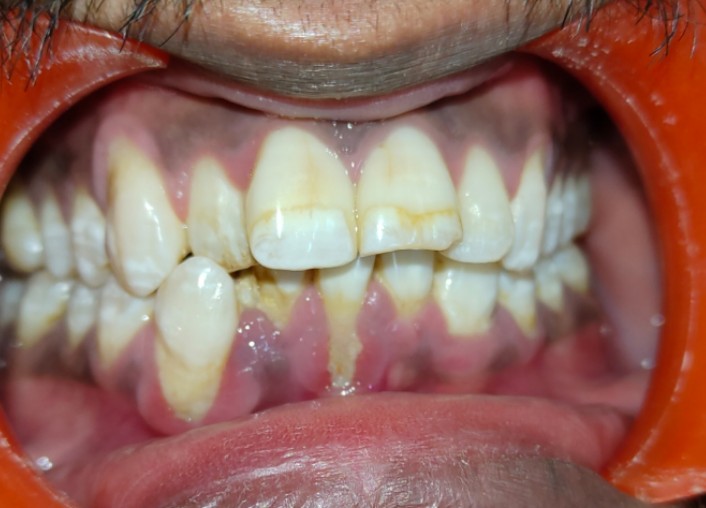Classification of Fluorosis Stains on Teeth

Dental Fluorosis definition – It is defined as the Hypoplasia or Hypomineralization of the Enamel or Dentin of the tooth produced by Chronic Ingestion of excessive amounts of fluoride during the period of tooth development.
The age at which Fluorosis can affect the developing teeth ranges between – 22 months to 5-7 years of age.
In simple terms, Dental Fluorosis is whitish, yellowish to brownish discoloration of teeth due to overexposure of developing permanent teeth to fluoride. In most cases Fluorosis is not harmful but just a cosmetic concern. Fluorosis is caused by when the developing teeth are exposed to fluoride during developing stages – below 8 to 10 years of age. Already erupted teeth cannot be affected by excess exposure to fluoride.
What is the Ideal Fluoride levels in Drinking water by Age:
- Birth to 6 months – Not required
-
6 months to 3 years – 0.25 mg/day for <0.3 ppm -
3-6 years – 0.50 mg/day (<0.3 ppm) and 0.25 mg/day (0.3 to 0.6 ppm) -
6-16 years – 1 mg/day (<0.3 ppm) and 0.50 mg/day (0.3 to 0.6 ppm)
What is the Ideal amount of Fluoride in Toothpaste for Children:
- 0.3 to 0.5 grams of Fluoride can be swallowed while brushing
- The maximum threshold for Fluorosis is 0.03 to 0.1 mg F/kg
There are four Indices which are used measure Dental Fluorosis:
- Deans Fluorosis Index
- Community Fluorosis Index (CFI)
- Tooth Surface Index of Fluorosis
- Fluorosis Risk Index
Deans Fluorosis Index Classification-
- Normal – Smooth, glossy, pale creamy-white translucent enamel surface
- Questionable – A few white flecks or white spots (Chalk like) also called as Mottled Enamel
- Very Mild – Small opaque, paper white areas covering less than 25% of the tooth surface
- Mild – Opaque white areas covering less than 50% of the tooth surface
- Moderate – All tooth surfaces affected, marked wear on biting surfaces, brown stain may be present
- Severe – All tooth surfaces affected, discrete or confluent pitting, brown stain present
Community Fluorosis Index (CFI)-
It is a modification of Deans Index where a numerical value is given to each category, which is useful in comparative studies. It is done on the basis of the number and distribution of individual scores, a community index for dental Fluorosis (Fci) can be calculated by the formula.
Fci = Sum of (number of individuals) / number of individuals examined
Tooth Surface Index of Fluorosis (TSIF)
It is used to measure the prevalence and Severity of Fluorosis which is significant to Public health. This is considered to be more sensitive in identifying mildest forms of fluorosis as compared to Deans Index. This can be used in both primary and permanent dentition.
- 0 – No evidence of Fluorosis
- 1 – Definite evidence of Focal white areas less than one-third of enamel
- 2 – White area at least 1/3 but less than 2/3
- 3 – At least 2/3 of visible surface
- 4 – Enamel staining in addition to any of the above
- 5 – Discrete pitting w/o staining
- 6 – Discrete pitting with staining
- 7 – Confluent pitting (fused), large areas of enamel may be affected or missing
Fluorosis Risk Index
Used in Analytic studies which is used to identify risk factors for fluorosis. It divides the buccal and occlusal surfaces of each tooth into four zones based on the age at which calcification begins.
- Class 1 – formation began in 1st year of life
- Class 2 – formation began 3-6 years of life
Mechanism of Action of Fluorosis:
As we know Fluorosis is caused due to excess intake of Fluoride during the developmental stages of tooth development. The source of excess Fluoride can be from any of the following sources –
- Excess Fluoride in Drinking water (Most common)
- Excess use of Fluoride toothpaste
- Consuming food or drinks made from fluoridated water
- Excess use of Fluoride tablets
Due to excess intake of Fluoride leads to damage of the secretory ameloblast resulting in changes seen on the Enamel surface. It leads to porosity in Enamel due to either change in composition of Enamel matrix or due to a disturbance of the cellular processes during the maturation of enamel. This is called as Mottled Enamel which is characterized by minute white flecks or yellow or brown spots or irregularly scattered over the surface of the enamel.
Mottled Enamel is also Classified by Al Alousi et al into 6 types as follows:
- Type A: White area less than 2 mm
- Type B: White area more than 2 mm
- Type C: Brown area less than 2 mm
- Type D: Brown area more than 2 mm
- Type E: Horizontal white lines
- Type F: Horizontal brown lines
The teeth most frequently affected by Fluorosis are Canine and Pre Molars/ along with 2nd and 3rd molars. The lower incisors are the ones which are rarely affected while the deciduous teeth are the very rarely affected tooth.
References:
Dental Fluorosis – The Risk of Misdiagnosis
Dental Fluorosis – ScienceDirect.com



